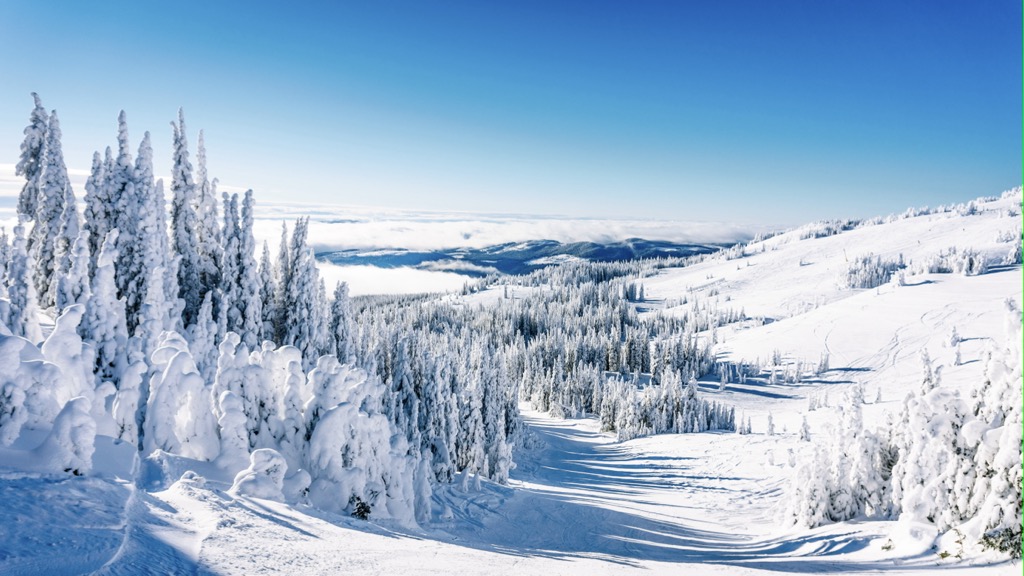Get PeakVisor App
Sign In
Search by GPS coordinates
- Latitude
- ° ' ''
- Longitude
- ° ' ''
- Units of Length
- Temperature

Yes
Cancel
Share ×

Scan the QR code and open PeakVisor on your phone
❤ Wishlist ×
Choose
Delete
Revelstoke Mountain Resort (RMR) is one of over 80 ski resorts in the province of British Columbia and one of more than 250 in Canada. However, it’s one of B.C.’s most famous ski areas; the resort’s primary claim to fame is its vertical drop, which, at 1,710 m (5,620 ft), is the biggest in North America - and really anywhere outside of Europe, for that matter. Revelstoke also boasts about 10 meters (400 inches) of annual snowfall, a long ski season stretching from December through mid-April, and excellent off-piste skiing. Just four lifts service 1,263 hectares (3,120 acres) of skiable terrain. The resort also operates a heliski company - Selkirk Tangiers Heli Skiing - from the base area (which is very much visible to us mere plebian resort skiers).
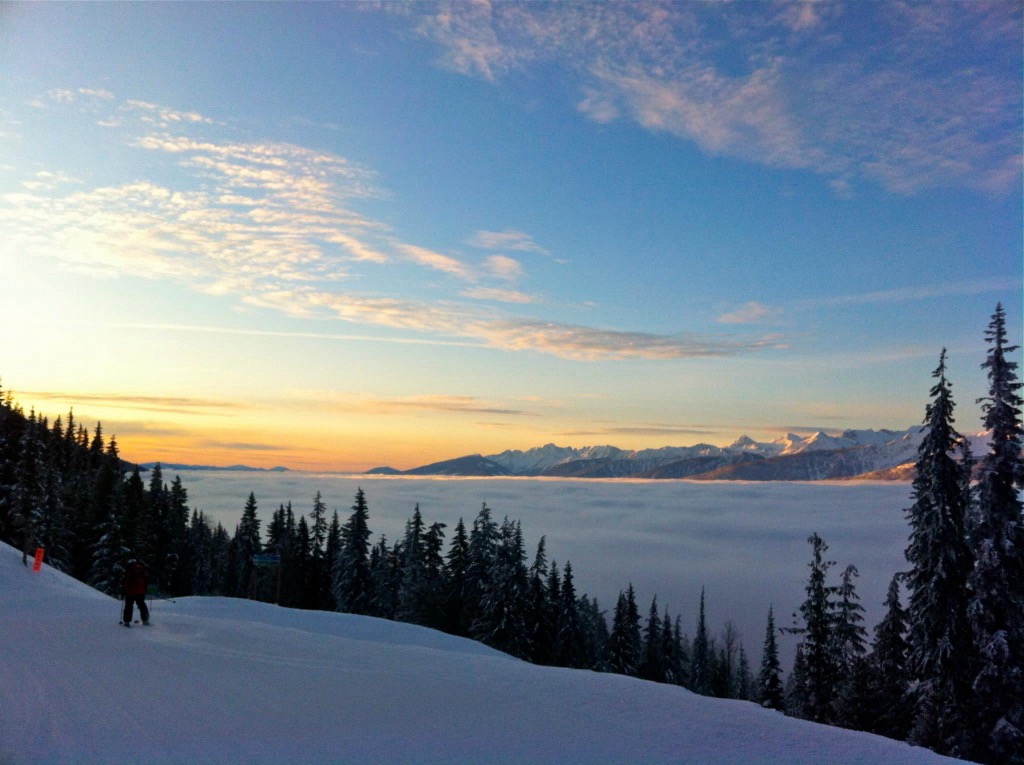
Ski mountains are all magical places, and Revelstoke is no exception. After all, we’re talking about getting pulled up a mountain and sliding down on snow. I spent six weeks here during December and January and will share some of the knowledge and tips I learned then. However, several issues keep me from really embracing Revelstoke as the lift-access powder skiing mecca that the marketing team has chalked it up to be. The mountain has too many powderhounds and insufficient lifts, making powder days congested affairs. But there are also great qualities that might make Revelstoke perfect for other skiers and riders. Read on for all the beta.
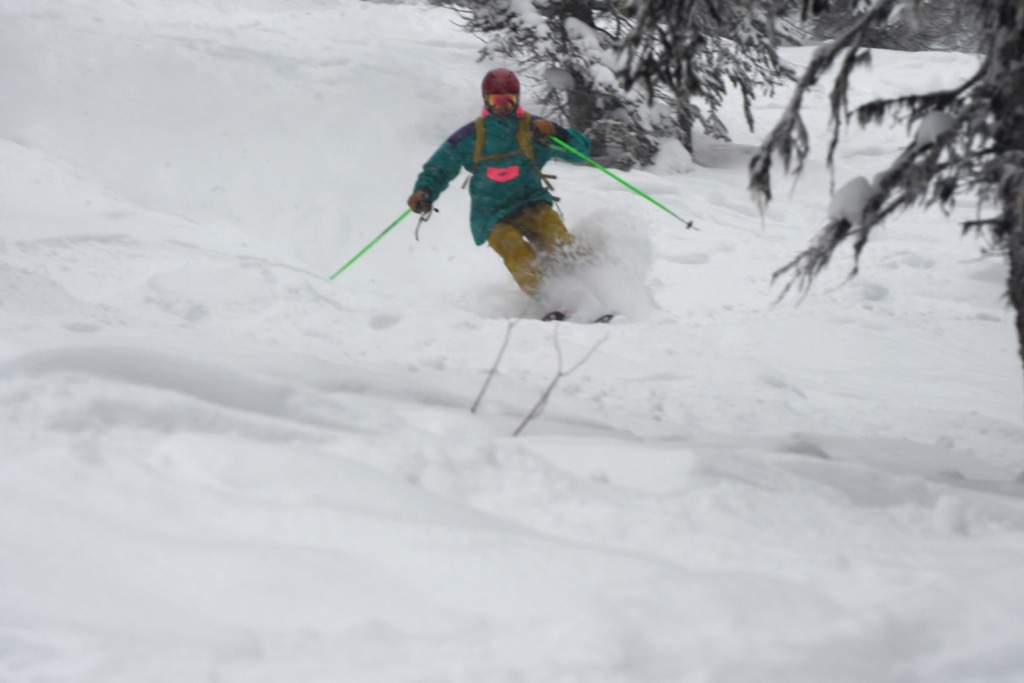
Revelstoke Mountain Resort is located on the slopes of Mount Mackenzie, just above the town of Revelstoke, B.C. The town and ski resort sits along the Columbia River on the northern tip of the Selkirk Mountains, one of four subranges comprising the Columbia Mountains (the others are the Cariboos, the Monashees, and the Purcells).
The Columbia Mountains, famous for the legendary “powder highway” circuit of ski areas, sit between the Coast Range to the West and the Canadian Rockies to the East.
Revelstoke is 220 km from the U.S.’s northern border, as the crow flies. Still, the town occupies a relatively southerly position with the vast BC province.
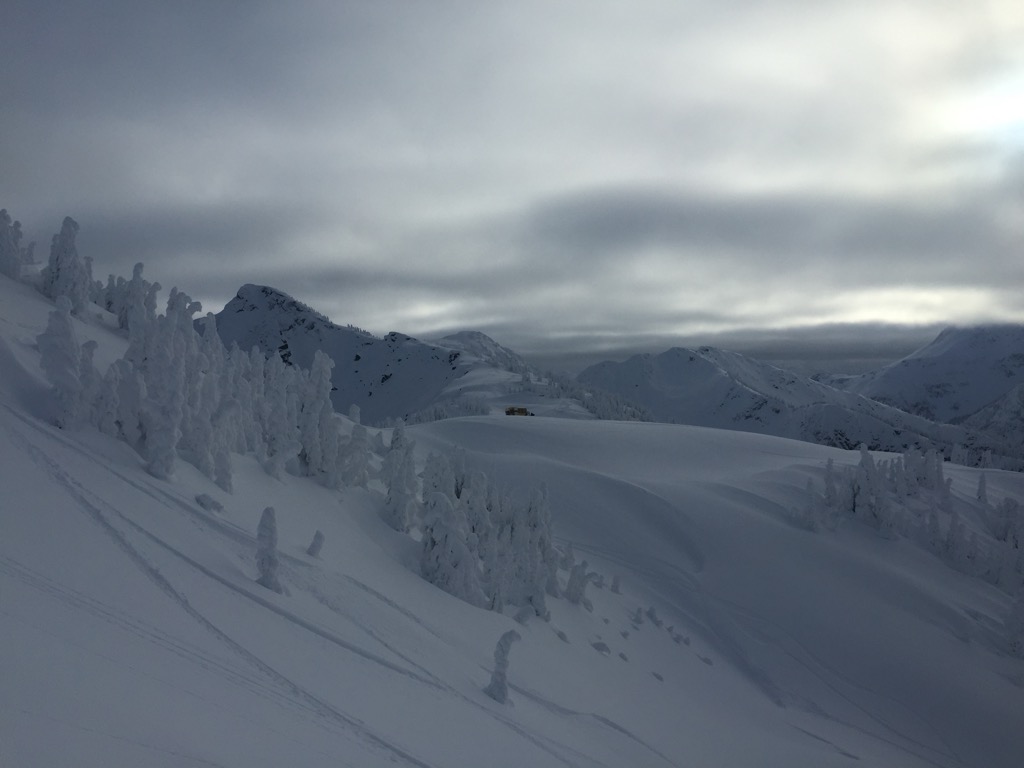
Getting to Revelstoke is easy to conceptualize—it’s located right along the Trans-Canada 1—but hard to achieve, as it’s 2.5 hours from the nearest city of any magnitude (Kamloops and Kelowna are equidistant).
Both Kamloops and Kelowna are only 2.5 hours from Revelstoke, and folks from the south-central interior of B.C. comprise a significant percentage of the resort’s skier traffic. These towns have airports, but they are more regional. Still, if you’re traveling from North America, you’ll be able to find a connecting flight here (though it may be more expensive). However, the drive to Revelstoke is much easier.
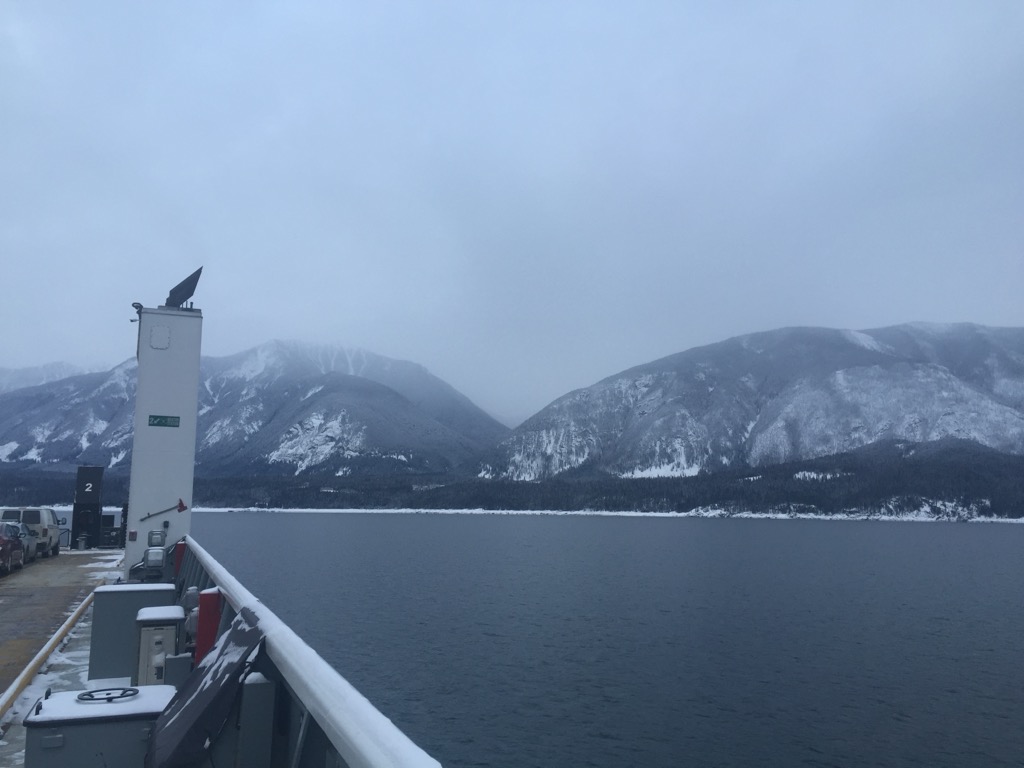
Calgary is 4.5 hours away and has a much larger airport. Many skiers from Calgary and Edmonton (another city north of Calgary) stick to the resorts around Banff and Kicking Horse as they are much closer. The drive requires crossing several mountain passes, including Roger’s Pass, which can get gnarly during snowstorms. Plus, you’re on the Trans-Canada 1 and sharing a one-to-two-lane highway with truckers from around the country. It’s not the worst thing, but it’s not a drive I recommend for the faint of heart.
Conversely, many skiers from the U.S. choose to drive and visit several different “powder highway” resorts on their trips.
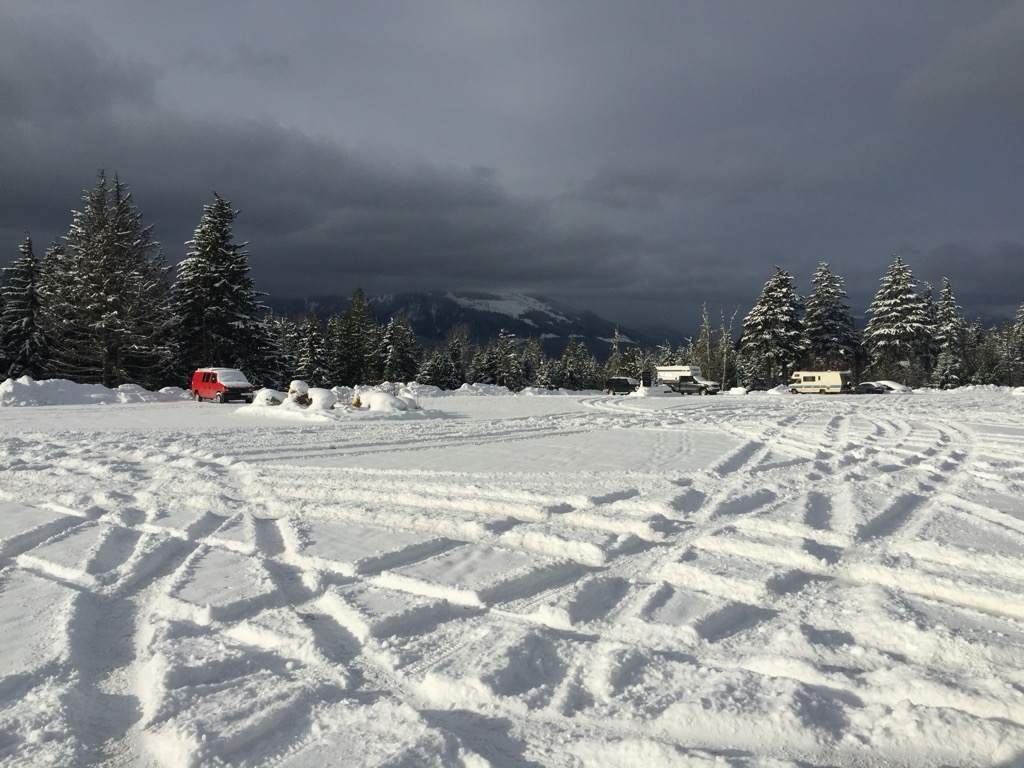
Revelstoke offers a healthy ski season ranging from early December to mid-April. However, the season feels much longer because the off-piste terrain above the Revelation Gondola is generally good to go right from the beginning of the season. I grew up skiing in New England and then moved to Colorado for several years, and I can attest that it’s usually groomer skiing until Christmas at those resorts.
The season below the Revelation Gondola is a bit shorter; the resort often has to blow artificial snow to open the home run piste, and it doesn’t always make it to spring, depending on the season. Climate change is weighing on ski resorts all over the world. Still, Revelstoke has suffered more than most because of the vast vertical drop, and much of the terrain is only accessible if the snowline reaches near to the base, which has become increasingly uncommon in the last ten years.
The backcountry skiing around Revelstoke can last a bit longer; often, turns are possible around Roger’s Pass starting in November and continuing into May.
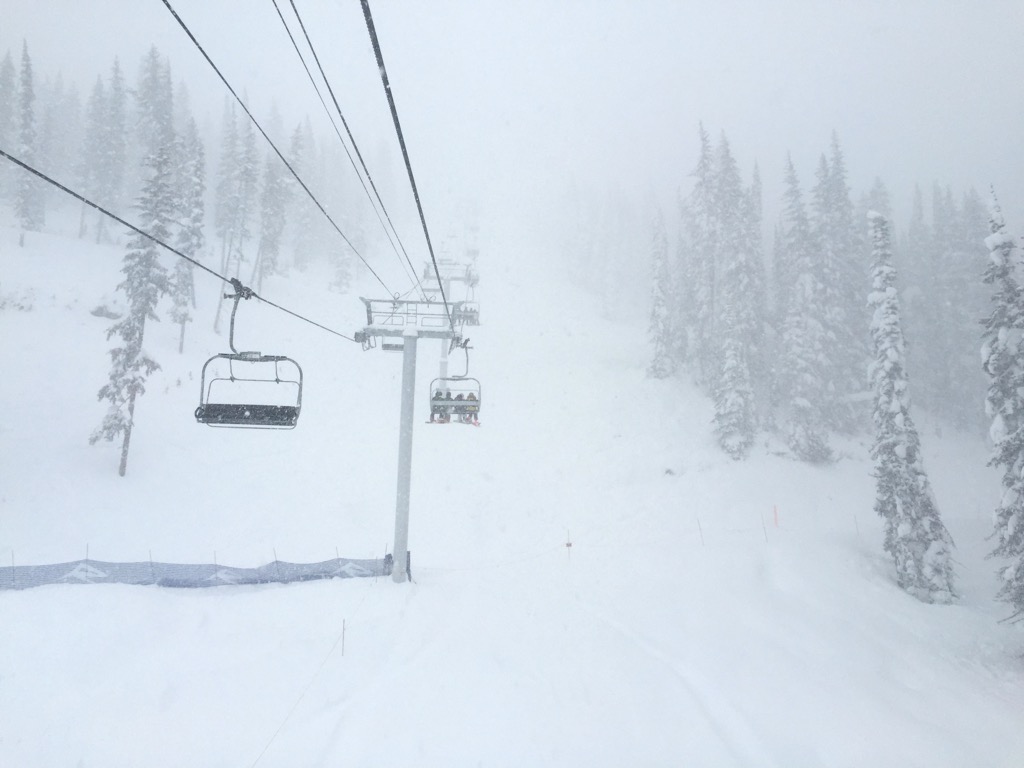
It’s no secret that Revelstoke reliably offers excellent snow conditions. Located at 50°N latitude, Revelstoke doesn’t receive much sun in the heart of winter, which can be good for powder but bad for classic bluebird days. It can often snow every day for weeks on end, and the dry periods are generally shorter than those in areas farther south. On the flip side, snow amounts are moderate, with most snowy days bringing less than 20 cm at a time.
The Columbia Mountains - particularly the Monashee and Selkirk subranges - are defined by a rare “temperate rainforest” climate. The rainforest is most visible at lower elevations, where vividly green moss carpets every square millimeter of the forest understory.
In the winter, this translates to quite a bit of snow at the upper elevations, where areas above the treeline can flirt with 12 meters (480 inches) of snow per year. Revelstoke sits on Mount Mackenzie on the edge of the range and averages closer to 10 m (400 inches). Meanwhile, the range’s crest (Roger’s Pass) to the east reaps the biggest rewards; the famous Illecillewaet Glacier stretches nearly 8 km (5 mi) from end to end.
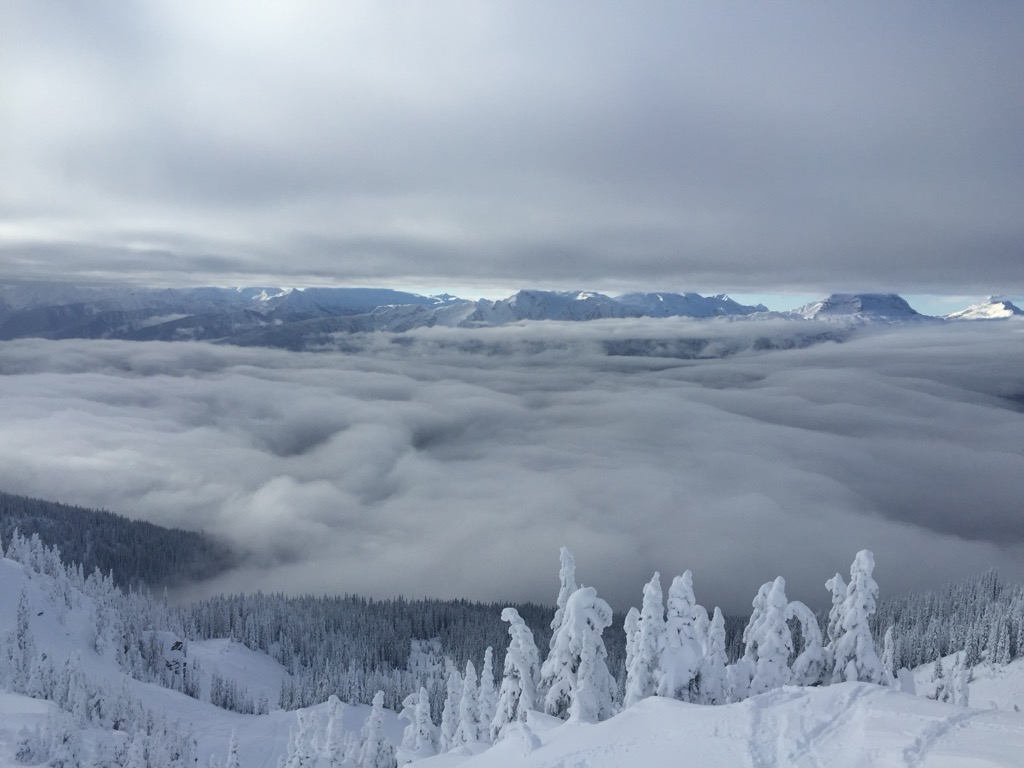
The mountain is a bit of a duality in terms of snow quality. The snow can be heavy and wet, but it can also be incredibly light. Often, it’s deep and light at the top and heavy and wet at the bottom.
The temperate rainforest also means lots and lots of clouds. If the weather pattern stays right, you can go weeks without seeing the sun in Revelstoke. It can snow every day during that time, but the lack of visibility up high can be frustrating.
Another issue in Revelstoke and B.C.’s coastal ranges generally is the dreaded four-letter R-word: Rain. When there is insufficient cold continental air, warm coastal air from the Pacific can bring raindrops. It happens here more frequently than the resort’s management would like to admit, especially on the lower mountain. The 2023-24 season has been particularly dreadful, with little snow below the Stoke Chair. Even during good seasons, expect four to five times more snow on top than at the Revelation Gondola mid-station.
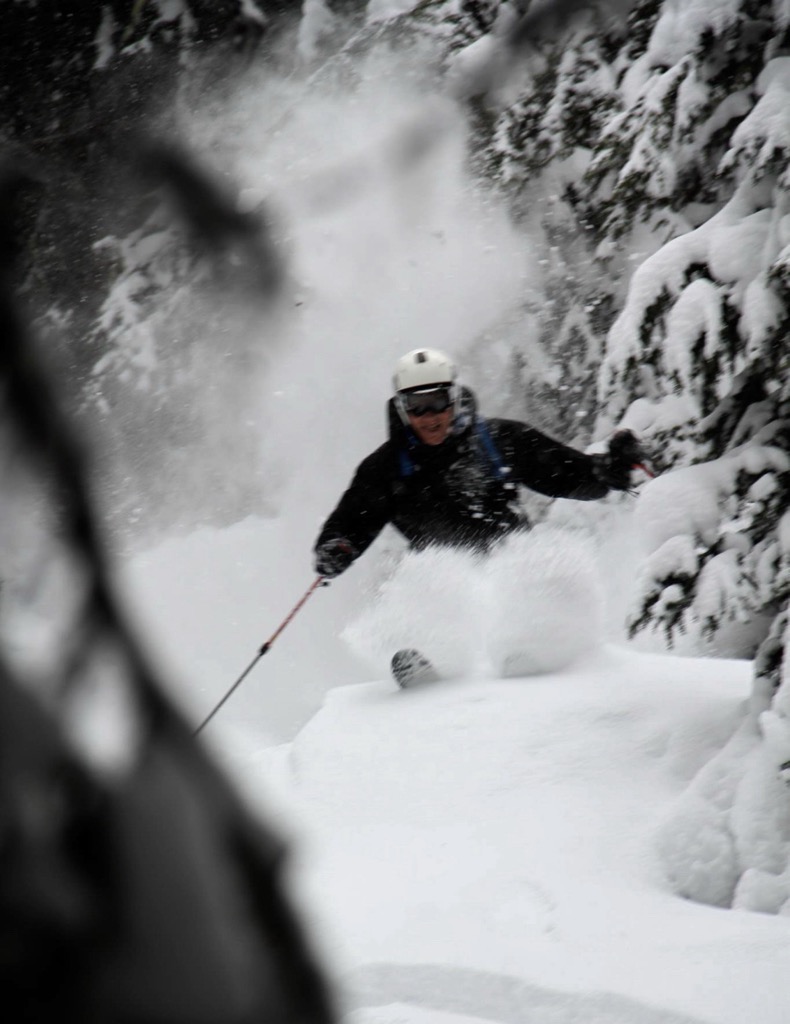
Any month can bring good or bad conditions in Revelstoke, but I’ll describe the season's usual arc.
Revelstoke’s early season is fruitful, especially in comparison to other regions. As mentioned earlier, Revelstoke’s entire upper mountain is often ready to go by opening day. I can’t stress enough how rare and incredible this is at a ski resort. Frequently, US skiers are stuck on groomers through Christmas, even though the big resorts open on Thanksgiving. However, on the years when a deep base has accumulated on the upper mountain before opening (most years), you can expect thousands (yes, literally thousands) of people to show up before the lifts start spinning. Hundreds of people slept overnight in tents the year I was there.
Additionally, December is statistically a wet month in the Pacific Northwest. The storm track tends to hang to the north, bringing steady snowfalls to the Columbias. Don’t expect much in the way of sun, and even on rare bluebird days, the sun angle is considerably lower in the sky than down south (hence, opening hours are shifted to 8:30 - 3:30)
January can see similar weather, but there also tends to be some colder, drier weather mixed in. You’re also more likely to have the lower parts of the mountain filled in. Because the slopes see little sun during this time, snow tends to stay cold and chalky, even long after storms.
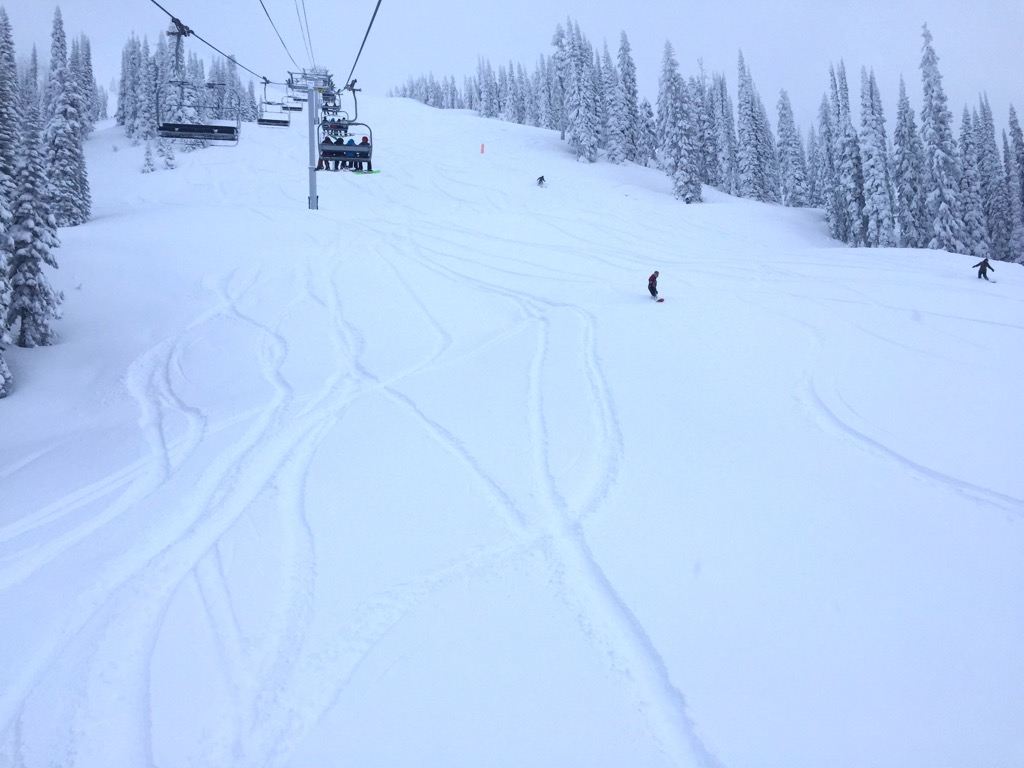
Generally, February and March are the prime months for skiing in North America, and Revelstoke is no exception. As the atmosphere warms, the storms can often carry more moisture for bigger overnight dumps. Plus, the base is deeper, and if you’re going to experience the incredible tree skiing of Revelstoke’s lower mountain, the coverage is more likely to be in at this time than any other. The upper mountain is almost certainly quite deep by this time; the base here can reach 3 meters (10 ft).
On the flip side, warmer air means rain is more likely on the lower mountain, especially in March and going into April. The mountain can get quite icy if warm/wet weather is followed by cold.
I usually would say crowds are worse at this time, but Revelstoke is so popular with powderhounds that it’s essentially crowded on any powder day, no matter what time of year.
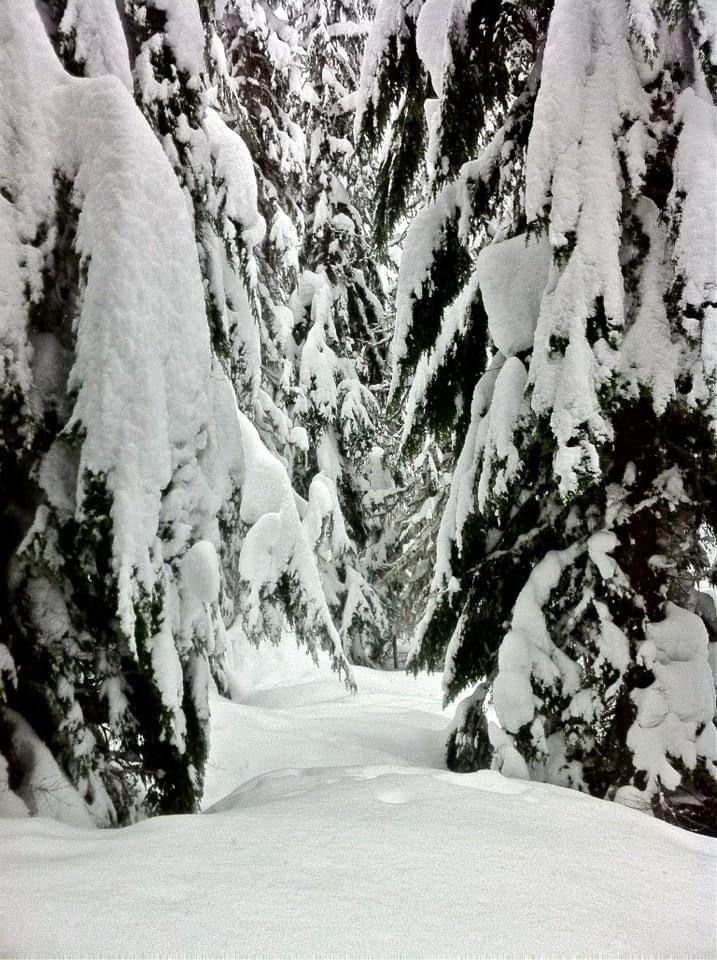
Revelstoke is incredibly simple to navigate; you’ll learn the ropes in half a day or less. However, the mountain holds many secrets tucked into the folds of forests between the lifts and pistes. Finding your line through the forests is what this mountain is all about. No written guide will ever be able to explain those parts of the mountain; you’ll have to experience it for yourself. I can, however, give a detailed description of the various parts of the mountain and lead you in the right direction. I’m usually not a fan of those cartoon resort maps, but RMR has a detailed one labeled with many gladed tree sections.
Just four lifts service the entirety of RMR’s terrain. The base village sits at 512 m (1,679 ft). From here, the gondola travels up to 1,690 m (5,544 ft). There are only two “full-service” lodges on the mountain: Revelation Lodge at the gondola mid-station and Mackenzie Outpost at the top station. The gondola accesses the upper mountain. Skiers can go right to the Stoke Chair or left for the mountain’s newest addition, the Stellar Chair. Stellar services just beginner terrain but allows skiers to access the Ripper Chair without first riding the Stoke Chair. Overall, this makes the mountain much more accessible to intermediates.
Everything below the top of the Revelation Gondola is considered the lower mountain, while the upper mountain comprises the Stoke and Ripper terrain. The top of the Stoke offers open bowl skiing: the Separate Reality, South, and North Bowls. You need to hike about 15 minutes (100 m / 330 ft) to reach the best parts of the North and South Bowls. You can traverse in, but the hike is a much better descent. Any terrain below the Ninja Traverse cat track requires a descent down to the Gondola mid-station; you can use this cat track to return and lap the Stoke Chair.
Slackcountry access from South Bowl to the skiers’ left requires skins for most of the terrain (although you can just duck the rope and ski straight down as well). It’s easy to return to the resort on the upper section of the Ninja cat track. Terrain from the Stoke Chair mainly faces west, while terrain from the Ripper faces north.
I’ll provide details on the chairlifts and mountain zones in the next section! I’ll discuss the slackcountry in the “Revelstoke Backcountry Skiing” section.
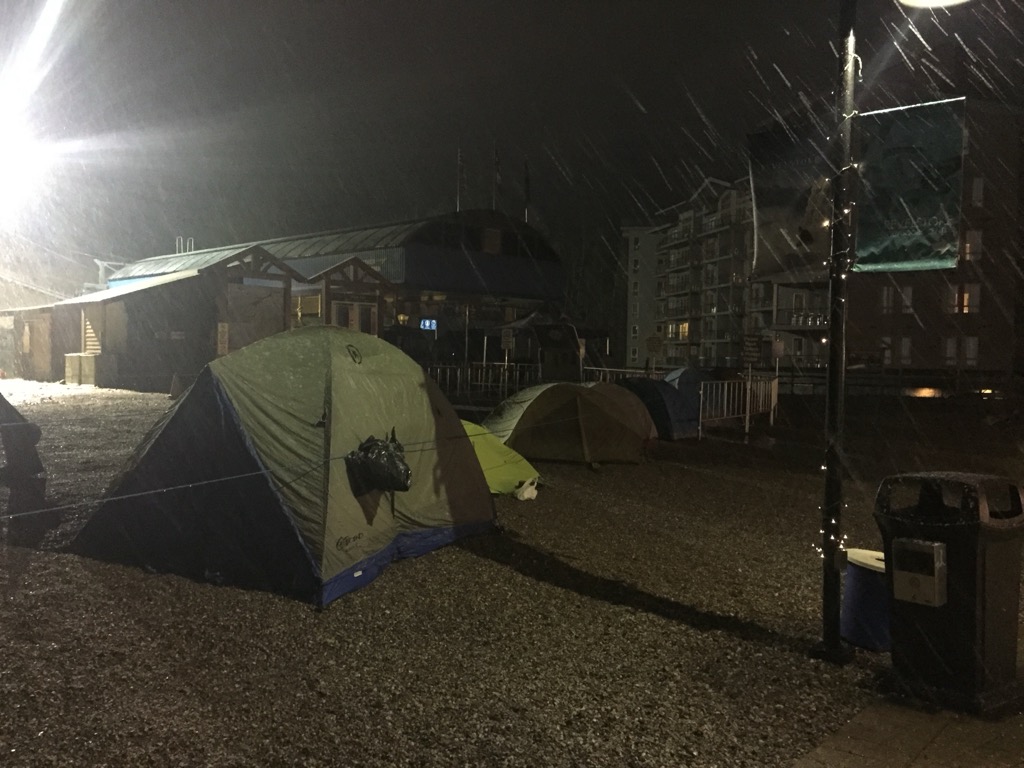
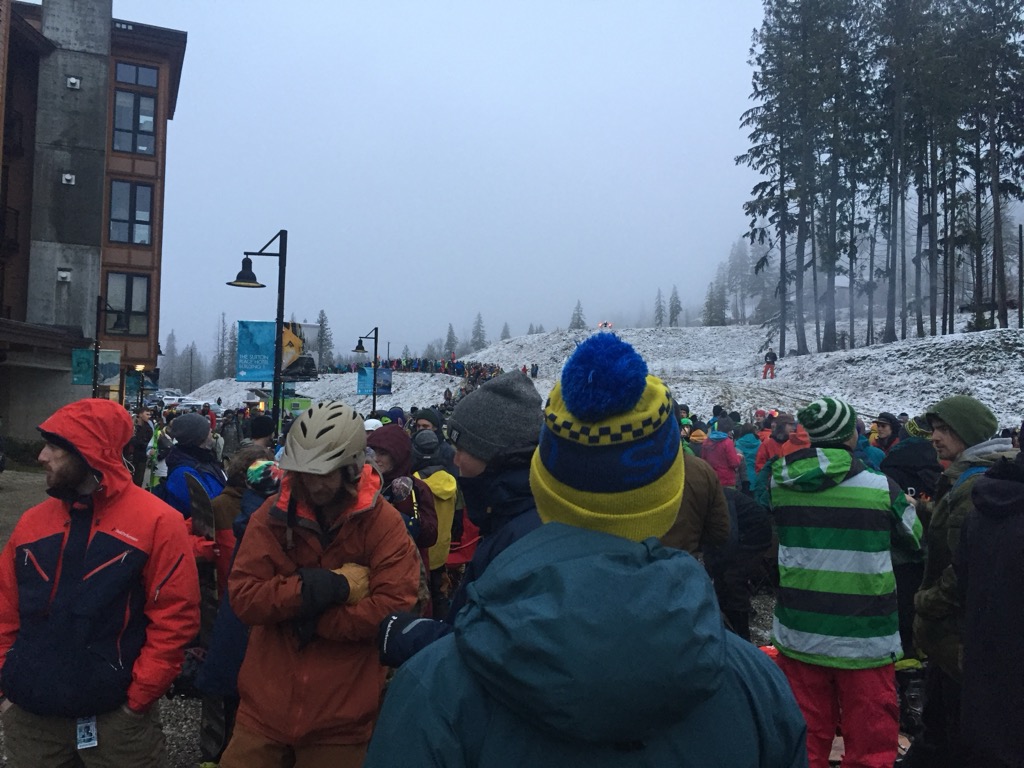
Here’s a complete breakdown of RMR’s lifts and slopes.
The Stoke Chair is by far the most crucial lift at RMR for anyone above an intermediate level of skiing, which, at Revelstoke, is the vast majority of visitors. The Stoke is a high-speed quad that services excellent terrain and is highly lapable. It usually stays open during storms, and the tree skiing offers plenty of visibility on lowlight days. Meanwhile, the open bowl skiing provides a big mountain feel and offers some of RMR’s longest continuous descents.
On the other hand, the Stoke has one really significant downside: it gets congested on powder days, with wait times often reaching 20 or even 30 minutes. The wait can be aggravating because it takes about 5 minutes to descend the 633 m (1903 ft) from the top.
When conditions are suitable at the bottom, the wait at the Stoke is not as bad. However, more often than not, conditions deteriorate toward the bottom, even when the snow is incredible up high.
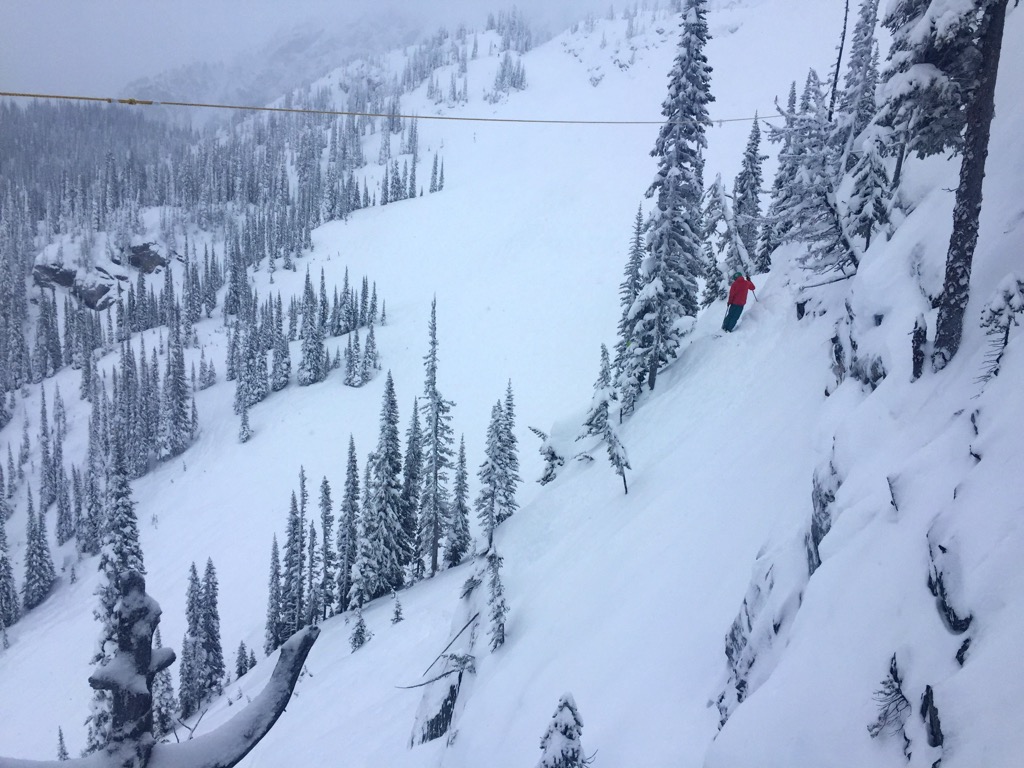
South Bowl is the expansive stretch of alpine terrain at RMR’s skiers’ leftmost flank, directly opposite North Bowl under Mount Mackenzie. The mountain begins to arc around to the south, and this bowl can pick up more sun than other parts of RMR. As a result, conditions start to deteriorate here once the sun comes out, especially in February and March.
Traverse right off the top of the Stoke. You hike to the “Subpeak” of Mackenzie to get the full extent of alpine skiing; otherwise, it all seems to be over too quickly before you hit the trees. The hike is a bit of a bruiser. It’s only 15 minutes long, but it’s sustained and requires some fitness. It’s not technical, though, and ski patrol always does a great job setting in the bootpack before it opens.
The bowl offers some perfect powder turns and then funnels into a series of avalanche paths (Hot-Sauce, Jalapeño), with gladed trees in between. These glades, like Tally-Ho, are some of the best tree skiing on the mountain. Unfortunately, it’s all over too fast. When you reach the Ninja Traverse, it’s time to head back toward the Stoke.
The glades closer to the Stoke, like “Iron Glaiden” and others, are also great. One word of warning: the “Last Spike” is an access road/cat track (and green trail) that winds the entire way down the mountain. Watch out because it cuts through the gladed sections on many different parts of the mountain. I came flying out of the trees and smacked the track on a few particularly low-light powder days.
Another issue with the South Bowl, in addition to its southerly exposure, is that the North Bowl is better and also starts at the Subpeak. The hike is strenuous, and you have to put your skis on your backpack, which means the whole endeavor takes about 20 minutes. It’s hard to resist dropping into North Bowl instead.
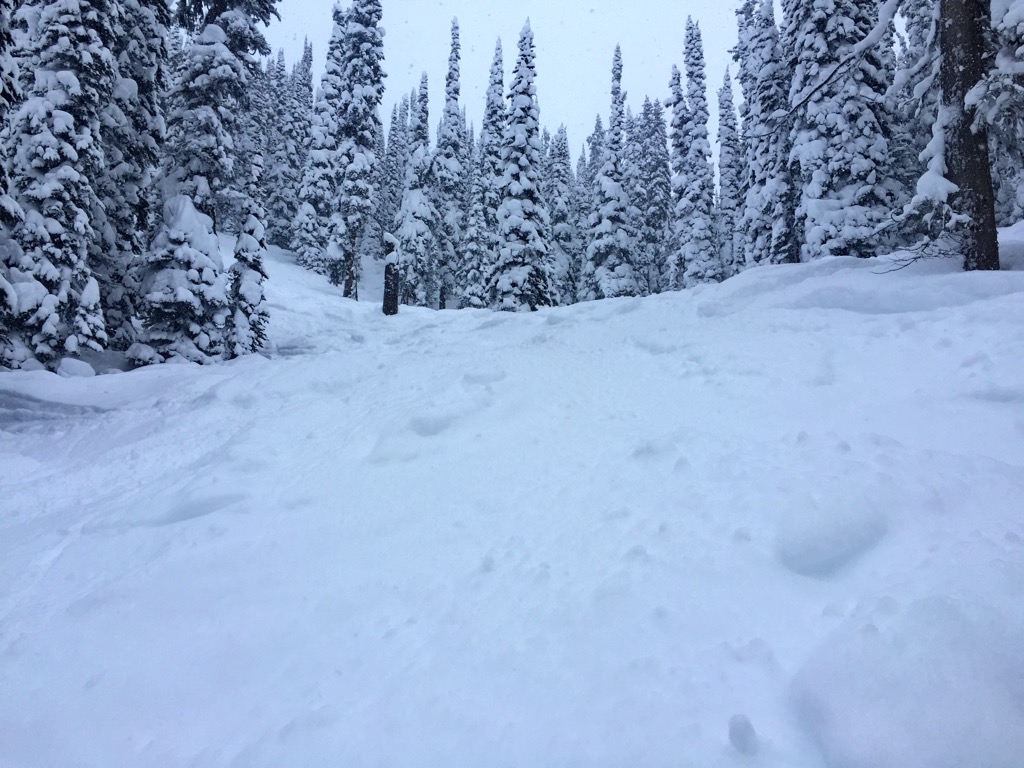
The Separate Reality Bowl is the easy-access bowl just to the right of the Stoke. It’s great because you don’t have to hike to drop in here, but its accessibility means it gets tracked out in about 5 minutes once the Stoke opens.
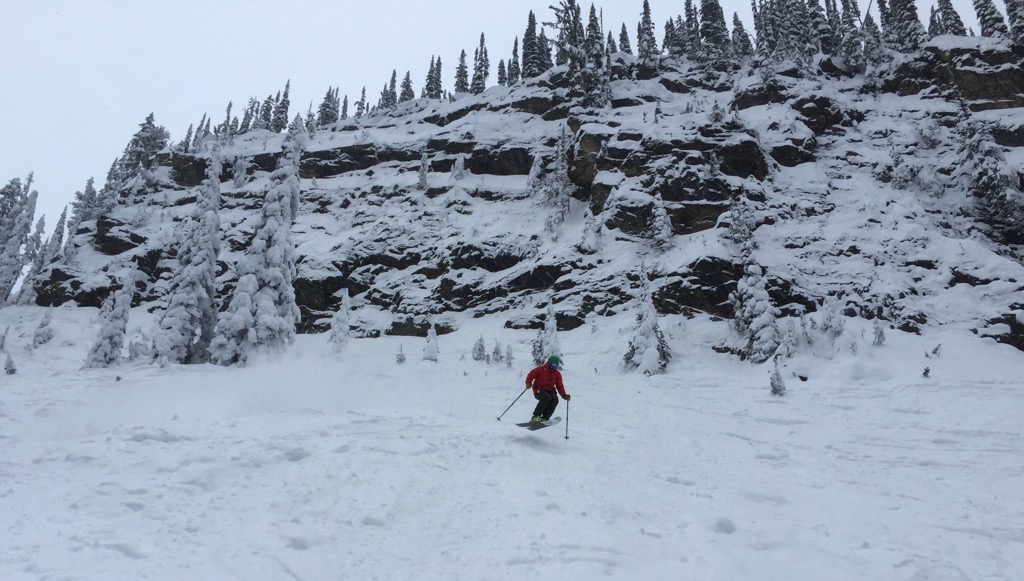
The terrain is open and playful, with loads of small cliffs to huck your meat off. The bowl funnels down into a ridge line called Vertigo Ridge if you stay skiers’ right or onto a blue run called Critical Path if you follow the fall line. Vertigo Ridge has many options, including some monster cliffs and other short but extreme terrain features. It’s one of the best zones on the mountain. That brings you to a cat track connecting with the Ripper Chair or the option to traverse back to the Stoke.
The glades around Critical Path are good but lack continuity, with the Last Spike cat track cutting through them. Vertigo Ridge is my preference here.
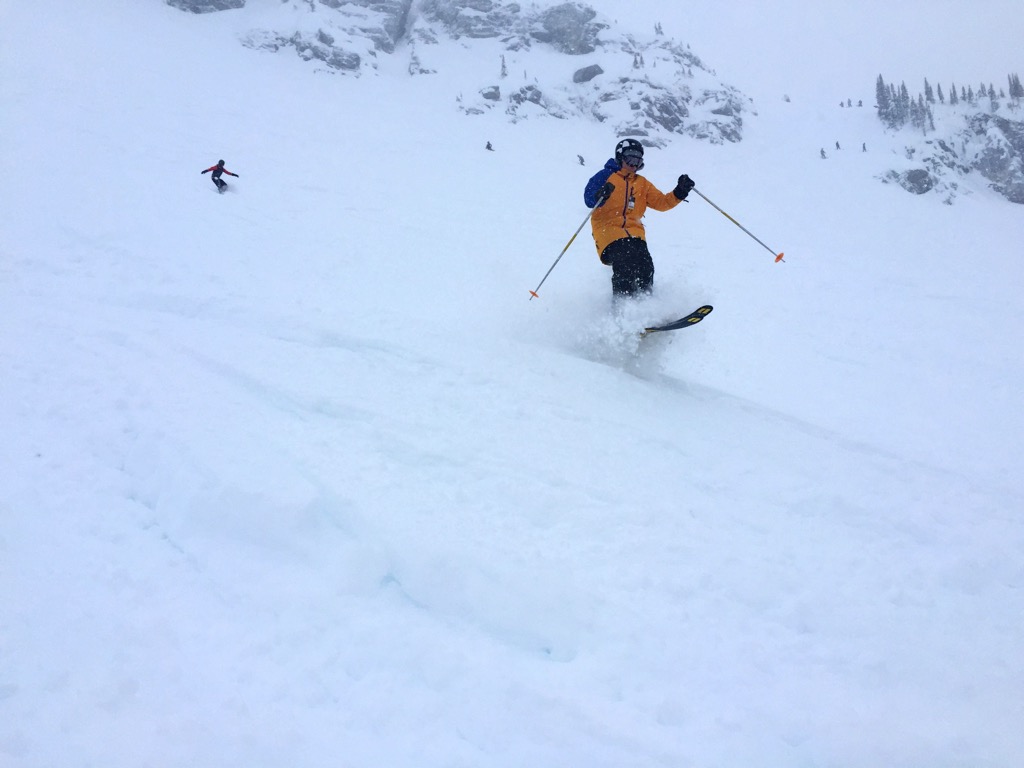
The North Bowl is the crown jewel of RMR’s terrain. The snow here stays soft well after a storm and often features that “bottomless” with even a light top-up. You could have 1 cm of snow at the base and 30 cm in the North Bowl. Never underestimate how easy it is to have a full-on powder day up here.
There are issues; the strenuous hike up to the Subpeak and the lack of visibility in the bowl present some challenges for skiing North Bowl regularly. Back here, it’s often pea soup, with no trees to provide contrast against the snow. You can also traverse into North Bowl to avoid the hike, but you end up with a short, tracked-up run to the Ripper.
The terrain from the Subpeak is superb. You’ve got expanses of powder skiing, like in Greely Bowl and Powder Assault, which resemble heli-skiing if you get there first. They’re the longest continuous descents you can find at RMR. Like much of Revelstoke, the terrain up here is playful, with many chutes and cliffs. You’ll understand why so many pro skiers and snowboarders are based here. It’s easy to find natural features and look good for the camera.
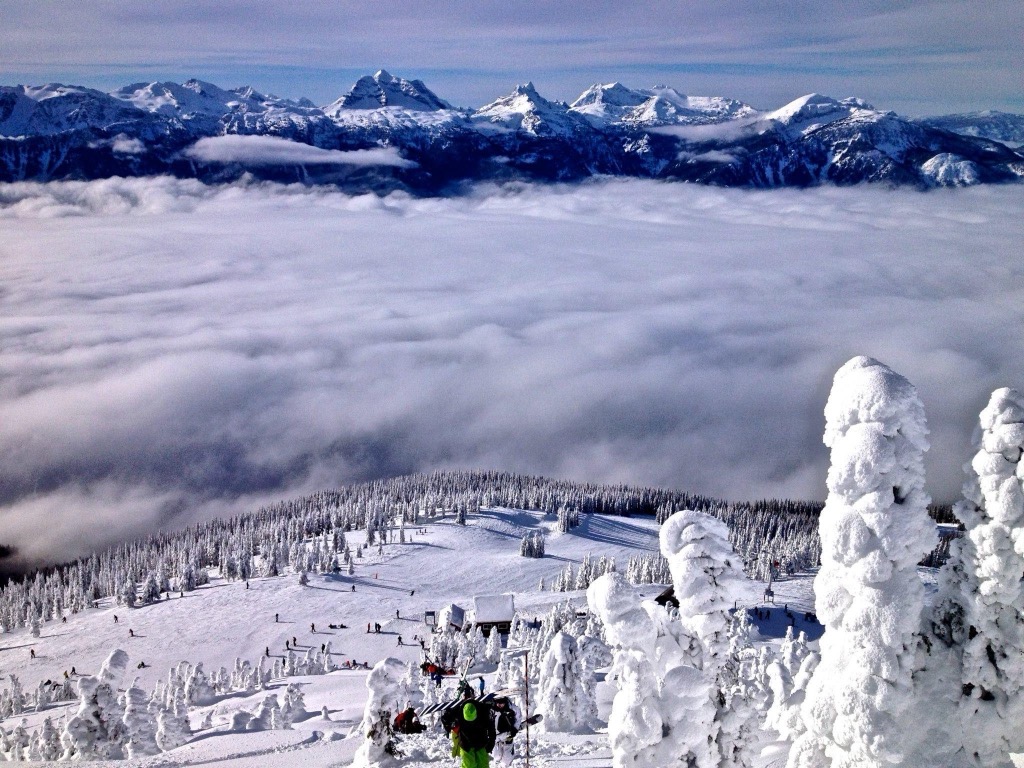
You can continue hiking past the Subpeak to Doors 1-4, slackcountry chutes that take you back toward Greeley. There are also plenty of couloirs from the upper reaches of Mackenzie—more on that in the backcountry section.
The North Bowl has the best terrain and snow at RMR, and the area suffers because of the lack of a lift. As much as I love a good hike, it’s difficult to repeatedly hike 115 m up a mountain, especially when lift passes (CAD 179 in 2024) are so expensive. You want to spend your time skiing, not hiking.
Even with the hike, fresh tracks don’t last longer than the time it will take to do one lap here. Plus, you must commit to a series of long, flat runouts down to the Ripper Chair, then ride that up and traverse back to the Stoke. It’s well over an hour for a great but relatively short descent.
The ability to lap this terrain would make Revelstoke far more attractive, even if it means more tracks in North Bowl. Other big mountain resorts—Telluride, Lake Louise, Jackson Hole, Palisades Tahoe, Mammoth Mountain, Whistler, and many more—have lifts servicing their best terrain (you have to hike Palmyra in Telluride, but it would be infeasible to build a chairlift there).
Revelstoke opened in 2008, making it one of the newest ski resorts in North America. The resort opened with the Revelation Gondola and the Stoke and Ripper Chairs. For the first few years, these three lifts seemed to carry as many skiers as visited the resort.
However, Revelstoke has become a famous destination in the years since, especially for skiers seeking powder and off-piste terrain. Three lifts are no longer adequate for carrying skiers up the mountain. Revelstoke will have you believe that nobody skis this mountain, and it’s true that there are no queues on weekdays with average snow conditions. You’ll likely ski right onto the lift.
The problem is powder days, and especially weekend powder days. On the days when you actually want to be skiing, you’ll be twiddling your thumbs in a lineup. Every winter, thousands of ski bums from Canada, Australia, the U.S., and Europe come here to spend a season. Combine that with all the day trippers from the interior valleys and Calgary and you’ve got some issues with only three meaningful lifts.
Lineups at the Revelation Gondola can reach epic proportions in the morning, which is a problem in and of itself. But, in my experience, the morning lineup was overshadowed by a consistent 20 or even 30-minute line at the Stoke on powder days. It made it difficult to ski more than a handful of daily runs and significantly impeded my satisfaction with the RMR experience. The Ripper is far less crowded but features much less exciting terrain. Meanwhile, the vast lower mountain is often unskiable due to a lack of snow or thaw/freeze events that make the conditions terrible.
Even more frustrating was the knowledge that several more upper mountain lifts are in the works in the “master plan,” a sort of mythical, sacred document that the resort management dangles in front of skiers and townspeople to keep the hope alive. Sixteen years later, the only addition was the small Stellar lift designed to get skiers to the Ripper without taking the Stoke first. The lift pass, at nearly CAD 200, is quite expensive, especially for Canada. My impression was that Revelstoke had a lot of potential but wasn’t delivering a product worthy of the hype and the price.
The Revelation Gondola transports skiers from the base area to the upper mountain in one fell swoop. It’s remarkably efficient and cozy, and if there's enough snow on the lower mountain, it accesses some incredible terrain in its own right.
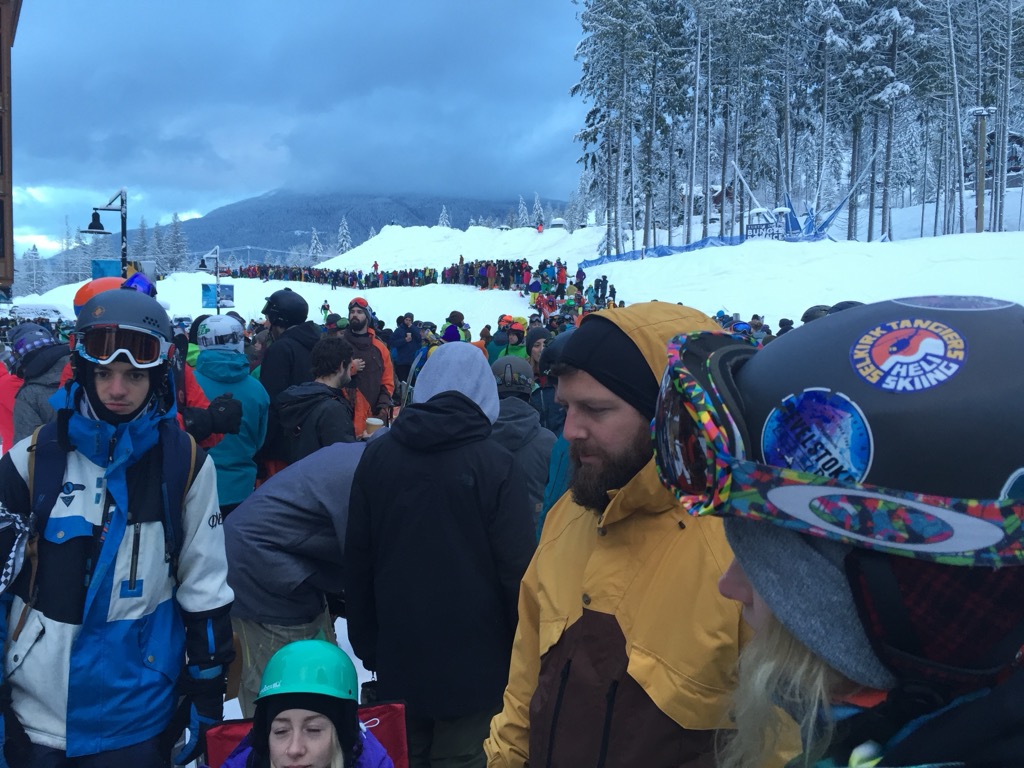
If you’re lacking inspiration while riding up the Gondola, you clearly haven’t looked down yet. Below the second stage of the Gondola lurks Kill The Banker, Revelstoke’s legendary pillow line. When there’s enough snow, the rocks fill in, and you have one of the most playful lift-access runs anywhere. I'm sure KTB has made it into plenty of BC film segments.
Cutting right into the trees brings you to the “Conifers of Gnarnia,” some of the finest trees on the mountain (again, when there’s enough snow). After a few blissful minutes of well-spaced tree skiing, you pop back onto the Last Spike.
You can also cut left into the trees and join Critical Path glades, another great section of forest. I recommend hitting this one from the top of the Gondola, though. Dropping in between the Gondola and Stoke is an excellent first shout. Watch out for the cliffs/steep pillow lines about halfway down. It’s easy to get around them - or ski down them - but it’s important to be aware.
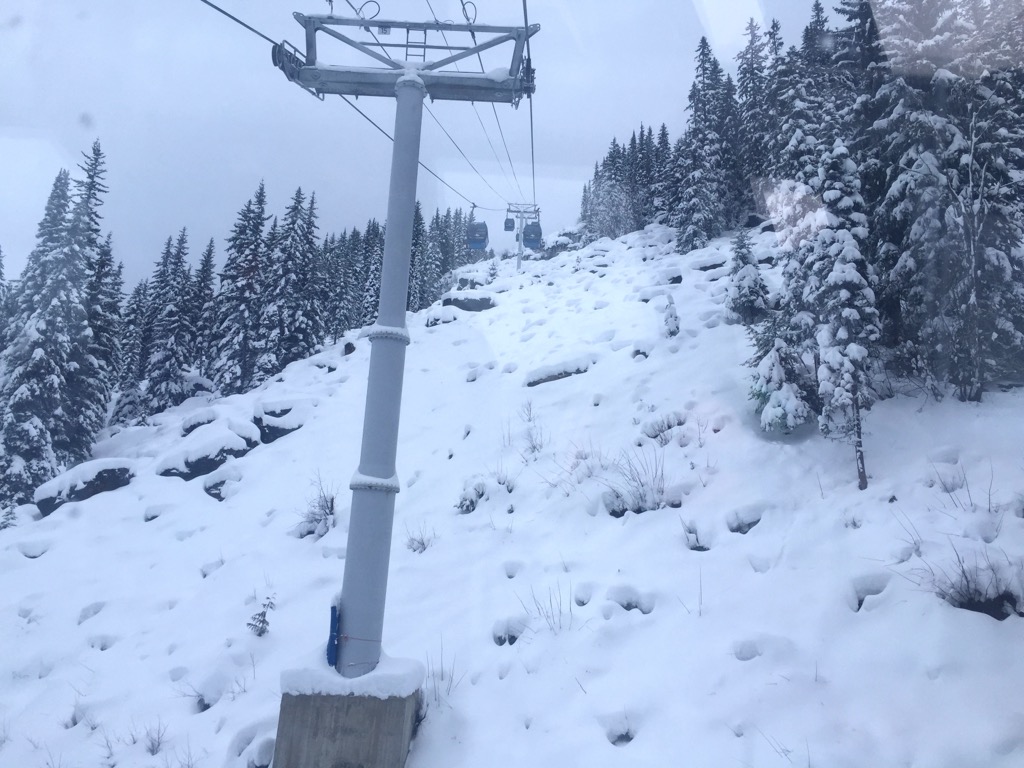
At most ski mountains, intermediate to advanced skiers are the dominant demographic. At Revelstoke, this range shifts up a notch to where I would be comfortable guessing that at least 80% of people on the mountain are expert skiers looking to ski off-piste terrain. Very few people come to RMR to ski pistes, but the pistes from the top of the Gondola are actually incredible. In fact, Pitch Black, Snow Rodeo, and Devil’s Club are some of the better pistes I’ve sampled. The length is just fantastic, and over 1400 m (4,600 ft) of elevation drop makes these pistes part of their own league.
One issue is that, even when there is snow down to the mid-station, the conditions can be marginal on the lower mountain. Repeated freeze/thaw cycles tend to make the lower section quite icy, while low coverage means rocks and grass can make an unwelcome appearance. I also remember a series of drainage ditches spread across some of these pistes, but I can’t remember which ones. You would repeatedly pass over large dips in the trail. I also remember the grooming as marginal, possibly because of the lack of coverage and snow conditions. It was decent at the top of the mountain.
Still, carving top to bottom down these pistes is a monster workout, and I spent quite a few days racing around here when the Stoke was backed up.
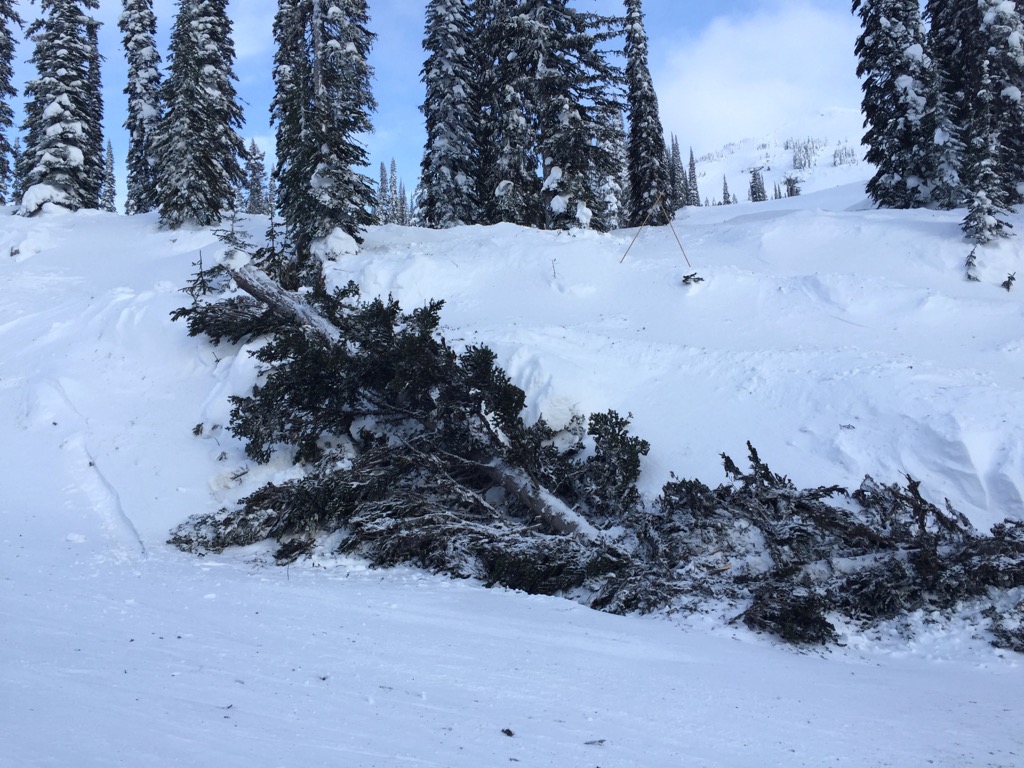
Undoubtedly, the Ripper is the forgotten stepchild compared to the Stoke Chair. Overall, the terrain is quite mellow. It’s an excellent zone for intermediate off-piste skiers looking to discover tree skiing without the steeps. Due to the elevation and northern exposure, you’ve got quite a bit of quality snow.
Some decently gladed tree sections are scattered throughout, and you have short, steep pitches if you know where to look. The Ripper’s terrain often lacks fall lines and can be a bit “traverse-y,” meaning you spend more time searching for lines than skiing them.
I would ski over here when the line at the Stoke became unbearable and when traversing out after skiing the North Bowl. I found it hard to find continuity in the skiing, but other skiers might not mind the short pitches.
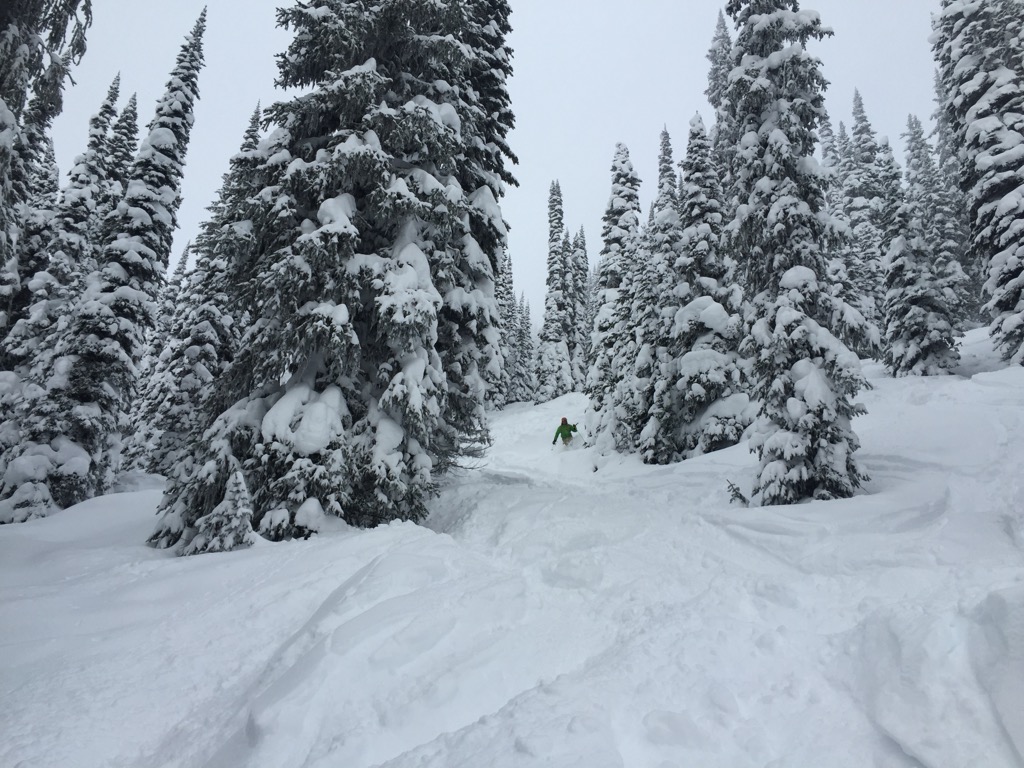
Backcountry skiing around Revelstoke is what makes the region genuinely world-class. Specifically, Roger’s Pass is one of (if not the) greatest ski-touring destinations in the world. The lift-access backcountry around the resort is decent. The snowmobile-accessed skiing is apparently incredible (I’ve never used a snowmobile), and there are several renowned heli-ski operations, including heli-accessed ski touring and hut stays. At least four cat skiing operations are also spread around the Selkirks and Monashees. Needless to say, the options here are pretty limitless.
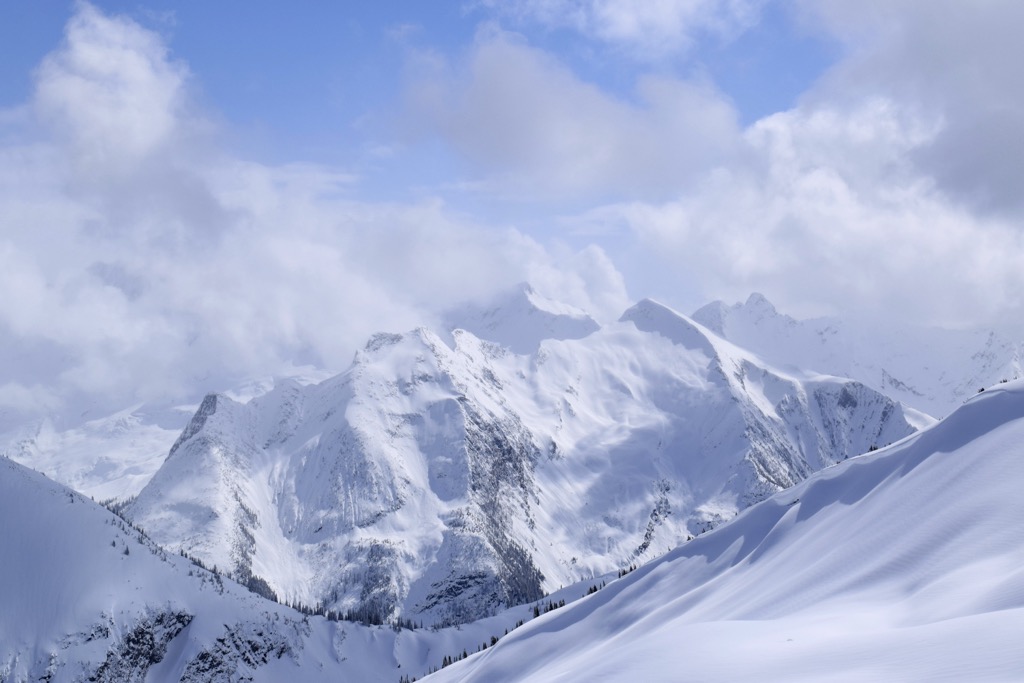
Mount Mackenzie is the best lift-access backcountry skiing from RMR. From the Subpeak, you continue along the ridge past the resort boundary, which will be marked by a rope/sign. South Bowl is in the sun (south-facing) to the right. After some cliffs on the left, you’ve got Doors 1-4, a series of steepish chutes that drain into the bowl below Mackenzie. They’re all north-facing, and some of the Doors have had issues with avalanches. You can just ski back into Greely Bowl heading left as the valley flattens out, making these some of the most accessible lift-access lines from RMR.
Continuing past the Doors, you can head toward the summit of Mackenzie. The classic testpiece is Brown Shorts, a steep couloir from just due north of the summit. Descend the ridge, then drop in on the left. The couloir is steep and shady; it’s steep enough that your sluff will run with you, so watch out. It’s also popular; some local shredder will probably ski it before you.
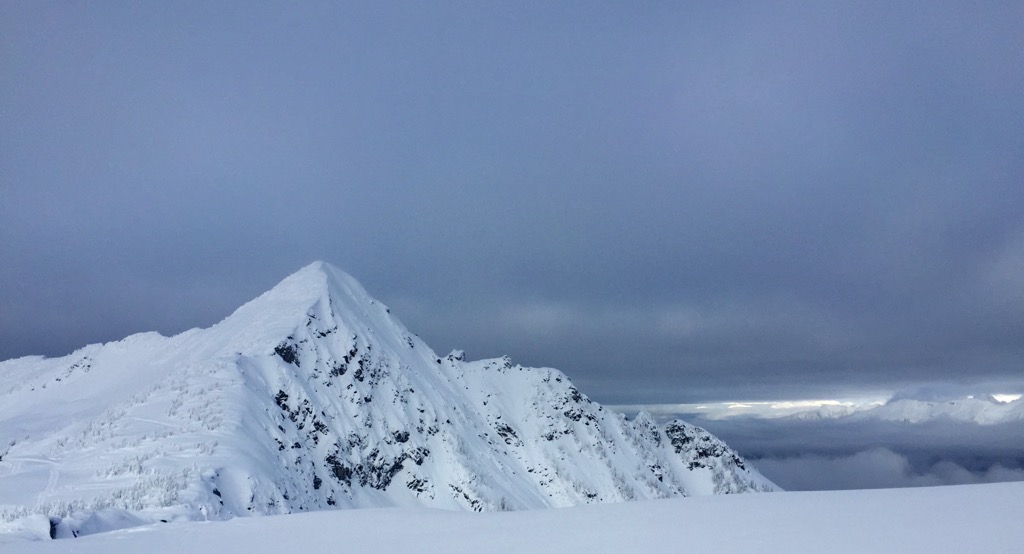
You can also drop off the backside of Mackenzie into the large valley below. If you head down the valley a bit, you can dip left into the trees, put your skins on, and hike back up to Greely Bowl. Watch out for cliffs on the descent.
For the Birthday Chutes, ski to the bottom of Greely Bowl and head right on the flats. Put your skins on and head up the shoulder of Mackenzie through the trees and eventually alpine. There are a few options for different descents; you can scope out your line from Greely Bowl before heading out.
The terrain around Mackenzie is north-facing and may become faceted, especially early in the season. It’s more of a later-in-the-season kind of thing. In December and January, the best slackcountry is usually the south-facing terrain further afield from South Bowl (described below).
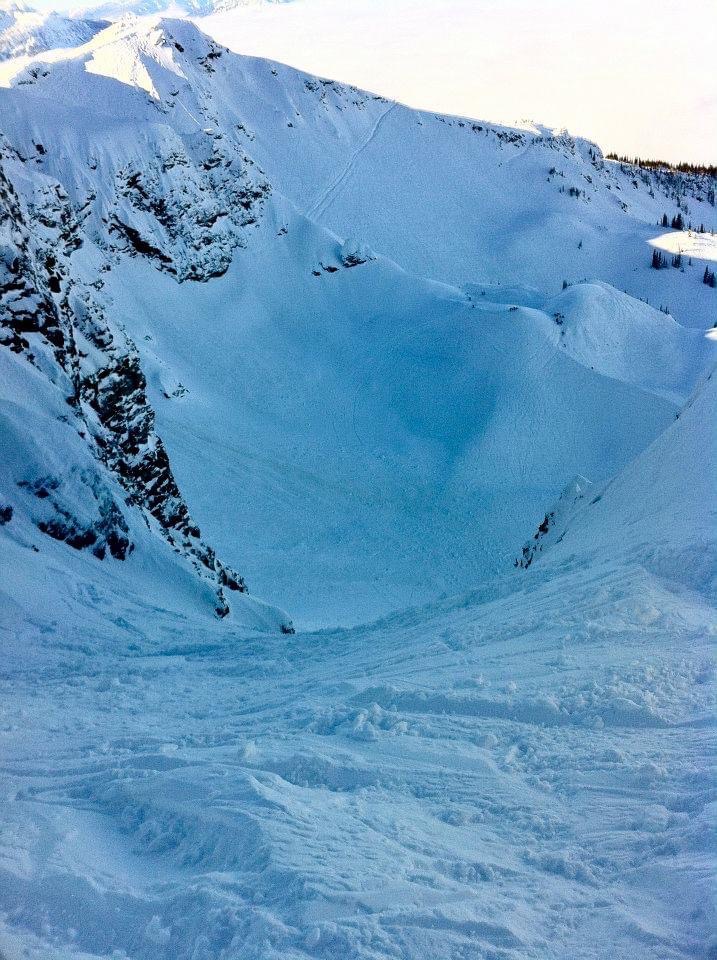
This terrain is actually pictured on the official RMR Trail Map. It’s south-facing, so it's best in December and January, around the solstice. It gets hammered fast once the spring sun starts shining. Revelstoke used to run cat skiing here, but I’m unsure if they still do. If not, it’s better for us skiers who are willing to put in a bit of work from the resort.
You need skins to ski back here. You can traverse from the lift until you reach the gate, put on your skins, and head up toward the ridge. A series of drainages descend into the forest, and the tree skiing at the bottom is especially sublime. You can stay along the ridge until you reach Montana Bowl at the far end or drop in after 20 minutes or so.
No matter where you drop in, you’ll reach a cat track. Turn right, and it eventually joins with the Ninja Traverse and heads back to the Stoke. You have to skate and duck walk about 10-15 minutes on the way out. Alternatively, you can head left, put skins on when the track starts heading uphill, and reach some short but amusing pillow lines.
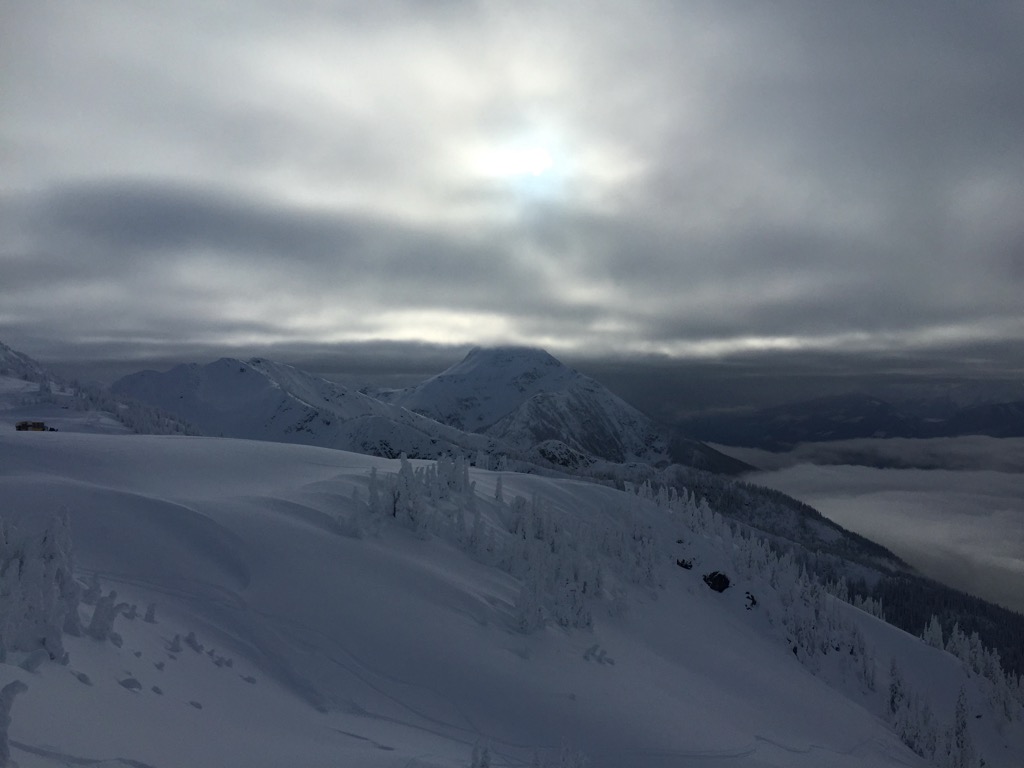
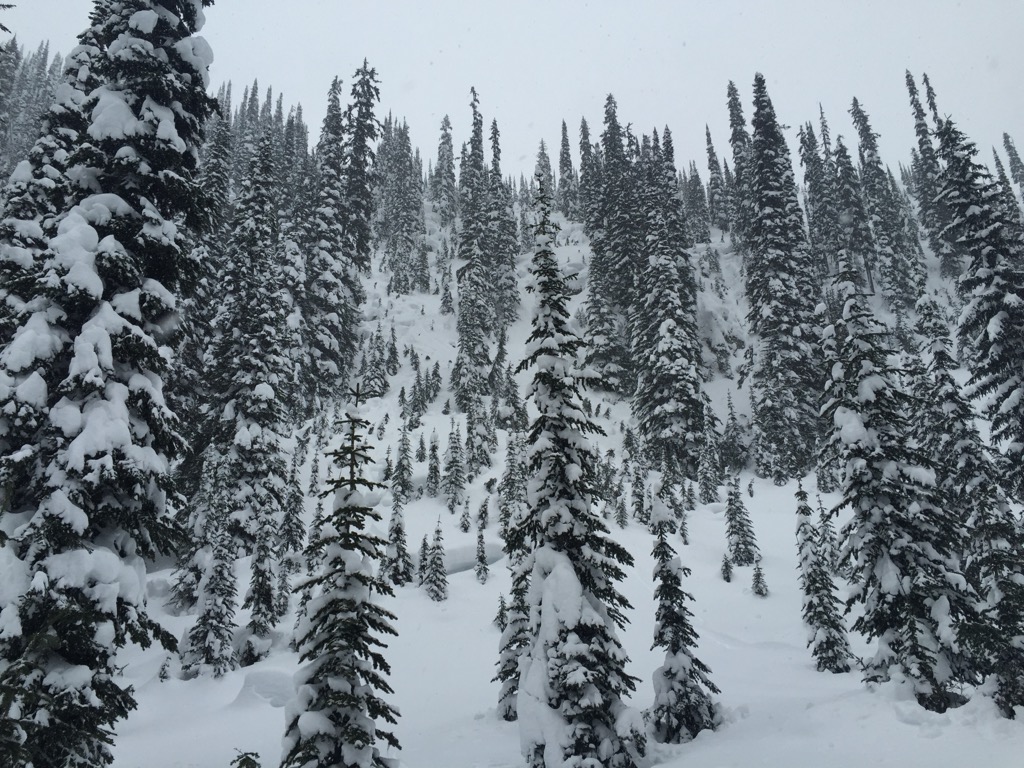
Rogers Pass is one of the world’s supreme backcountry zones. If and when I return to the Revelstoke area, it will be for a trip to Roger’s Pass rather than RMR.
Rogers Pass is where the Trans-Canada 1 weaves through Glacier National Park. These peaks are nearly as dramatic as the European Alps, with steep aesthetic summits and cascading glaciers. The park marks the crest of the Columbias and receives monumental amounts of snow. The pass is sheltered from the sun by its high latitude, prominent mountains with deep valleys, and the persistent clouds that blanket the Columbias during winter. From early December to mid-April, the snow quality fluctuates from good to legendary, with only a few exceptional crusty days. Thousands of ski routes crisscross the park. I’ll outline a few routes here, but to really explore the place, I recommend investing in a copy of Douglas Sproul’s Rogers Pass guidebooks, split into a North and South volume.
Generally speaking, the approaches are long. Another issue is that most classic lines are alpine and require reasonably stable weather. However, there’s also good tree skiing if you know where to look. There are old-growth forests where it’s like skiing through a cathedral, with the ancient trees well-spaced and devoid of lower branches.
Best of all, if you have a camper van or RV, Canada Parks allows overnight parking in the visitor lot at the top of the pass. It makes those early morning starts that much easier because the top of the pass is 45 minutes from either Revelstoke or Golden, the two closest towns.
To ski in certain zones, you’ll need to buy a Canada Parks pass and undergo a permitting process. It’s not too much of a hassle; before skiing, stop at the Discovery Centre at the top of the Pass for more information.
On the north side, I recommend exploring the zone around Cheops. Head up the valley directly from the Discovery Centre parking lot. On stormy days, you stick to the Hourglass trees on the lefthand side of the valley or the Ursus trees on the right. On clear days, make your way up to Video Peak and Balu Bowl (8812 Bowl) for some mellow powder skiing. That’s on the south side of the valley, though. For north-facing terrain, Cheops is home to the legendary STS Couloir. You traverse to the end of the valley, then head left and up the shoulder. If STS feels too spicy, you can first drop into the mellower North Bowl. You need to get permitted to ski around Cheops because of the military avalanche control.
The South side is home to some of the most famous ski tours at the pass, including the Seven Steps to Paradise. The parking for this one is just west along Highway 1 from the summit of the pass. It’s long (Asulkan Hut is nicknamed “a-slog-in”), so get started early. Look for signs that mention the Illecillewaet Campground, Wheeler Hut, or Asulkan Hut. Start hiking down the Valley, but instead of following the route to the Asulkan Hut, turn left and follow the Illecillewaet River. Soon, you’ll leave the treeline and gain the sprawling Illecillewaet plateau glacier. Follow the ridge past Young’s Peak and the infamous “Forever Young” Couloir, which can also be skied as a spicier alternative.
The descent follows a massive bowl for over 1,000 m (3,300 ft) of mellow powder skiing. The top half or third is glaciated; the ice and the northern aspect keep the snow quality in top shape. Once you reach the trees, you can skin back up to the Asulkan Hut (recommended, reservations required) and stay the night or traverse the valley back to the car.
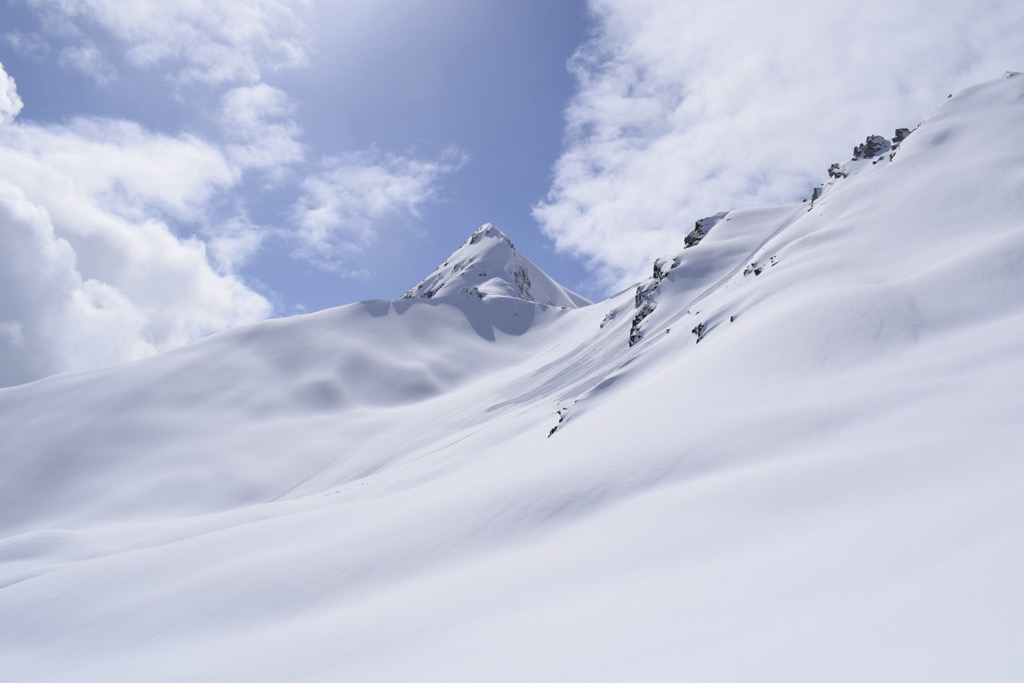
Day passes now retail at CAD 179, which is, well, really expensive. Sure, there are more expensive resorts, but they offer far more infrastructure for the money. The resort marketed heavily in the early days and monetized its notoriety; less than ten years ago, day passes were under CAD 100. But they haven’t added any infrastructure.
Season passes are at CAD 1400 if you buy them in April for the following season. For everyone else, it’s CAD 2000.
The best option for tourists is to buy either the Ikon Pass or the Mountain Collective Pass (amounts are in USD, not CAD):
If you only use your days at Revelstoke and no days at other resorts, the Ikon offers little savings over buying day passes. However, the Ikon Pass is an incredible deal because you can access over 50 resorts across North America and Europe. Even if you use all of your days here, you can still visit dozens of the best ski resorts on the continent and beyond
More than a dozen resorts offer unlimited access—the Ikon Pass is their season pass. Alterra Mountain Company owns these resorts; the others are partnerships.
The Revelstoke Nordic Ski Club is a one-stop shop for all your Nordic and snowshoe needs. It’s located about 10 minutes out of town across the Columbia River. The area features 30 km (17 mi) of trails and also allows backcountry access for snowshoers. The Nordic trails are groomed daily, so the club charges CAD 19 per day for an adult.
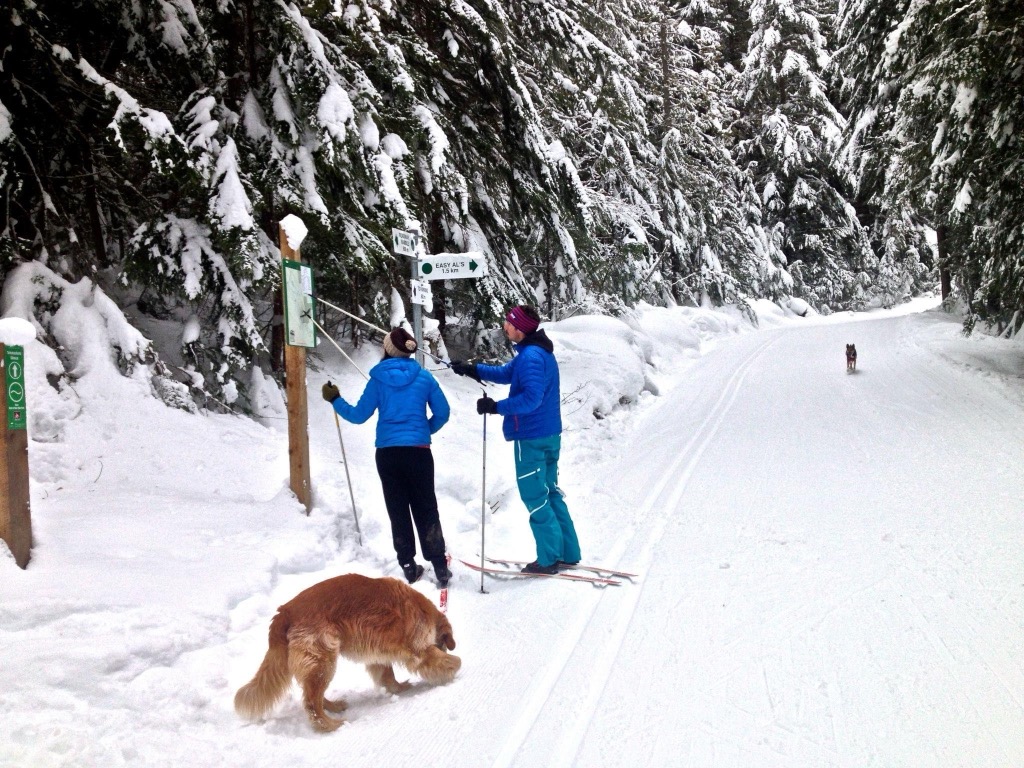
Revelstoke has a state-of-the-art information center for all your needs:
Revelstoke Visitor Information Centre
301 Victoria Road W.
PO Box 490
Revelstoke, BC V0E 2S0
Phone: +1 250-837-5345
One of my favorite things about Revelstoke was the community. There are all sorts of cool people from all walks of life. In addition to the ski mountain, here are some of the best places to experience this charming town and meet new people.
The aquatic center is a Revelstoke institution. Rather than chugging beers at some bar, you’re more likely to find friends and rehash your ski day in the hot tub or sauna. Between ski touring and skiing the terrain at RMR, the body can take a beating up here.
Plus, it’s far more affordable. A variety of passes are available, but it’s less than CAD 10 to spend the evening here. I would come down to the aquatic center for a soak several times a week. They also have a full-size pool and a fitness center. Moreover, the local library is right across the building for all your information needs.
The Village Idiot is a classic, lively ski town pub and restaurant. Take a seat at the bar, and you’ll likely meet a few people before heading out. The menu is standard: beer, pizza, burgers, etc. Everything is tasty, but it’s just the positive vibe here that makes it special.
Historically, many Japanese immigrants have come to Vancouver, bringing an exquisite circuit of great sushi restaurants to the province. The best sushi I’ve ever had has been in B.C. Kawakubo is not quite at that level, but it’s good. Pay them a visit after stopping by the aquatic center.
Kawakubo Revelstoke
Address: 109 1 St E, Revelstoke, BC V0E 2S0, Canada
Phone: +1 250-837-2467
Website: https://kawakubo-revelstoke.com/
If you can find a designated driver, it’s worth it to head over to the brewery for an après session. It’s located just a bit out of the central downtown, not within walking distance. These guys have been in the game since 1996 and won the Brewery of the Year award in 2017. I haven’t tried the food, but I was hooked on the beer and pretty much drank only this for the rest of my stay.
Mt. Begbie Brewing-Tasting Room
Address: 2155 Oak Dr, Revelstoke, BC V0E 2S1, Canada
Phone: +1 250-837-2756
Website: https://www.mt-begbie.com/
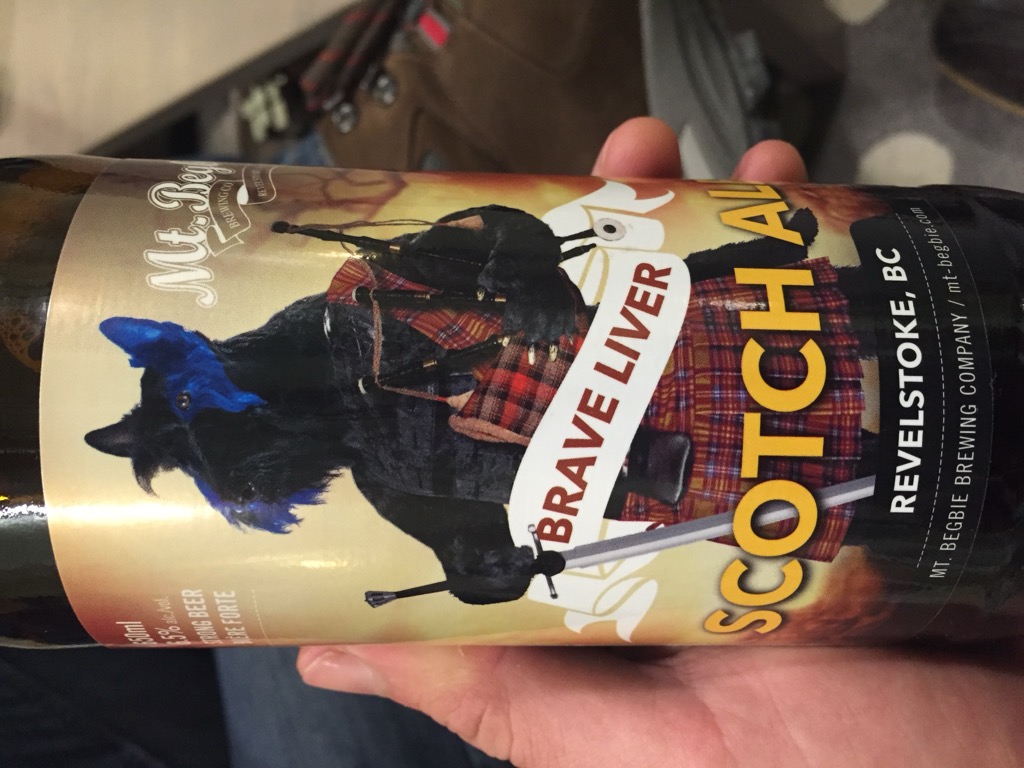
About an hour and a half from Revelstoke, just on the other side of Rogers Pass, is Kicking Horse Mountain Resort. KHMR is one of Canada’s larger ski resorts, with over 100 km (62 mi) of ski runs and a vertical drop of 1,260 m / 4,133 ft. The resort has more advanced terrain (128 runs, five alpine bowls, and 85 inbound chutes) than any other resort in North America, with plenty of steep chutes, gnarly bowls, and exposed alpine hikes. The closest town is Golden, BC, 9 mi (14 km) away.
Kicking Horse is slightly in the rain shadow from Revelstoke, so they get less snow. However, the snow is lighter, and the air is drier and colder, preserving the conditions.
Unfortunately, KHMR is on the Epic Pass, so you can’t link it if you have an IKON for Revelstoke. Otherwise, the two mountains are like brothers. They are both off-piste-oriented and have strong communities of local skiers and riders. They are also both underserved by their respective lift systems; like Revelstoke, KHMR could use a few more lifts.
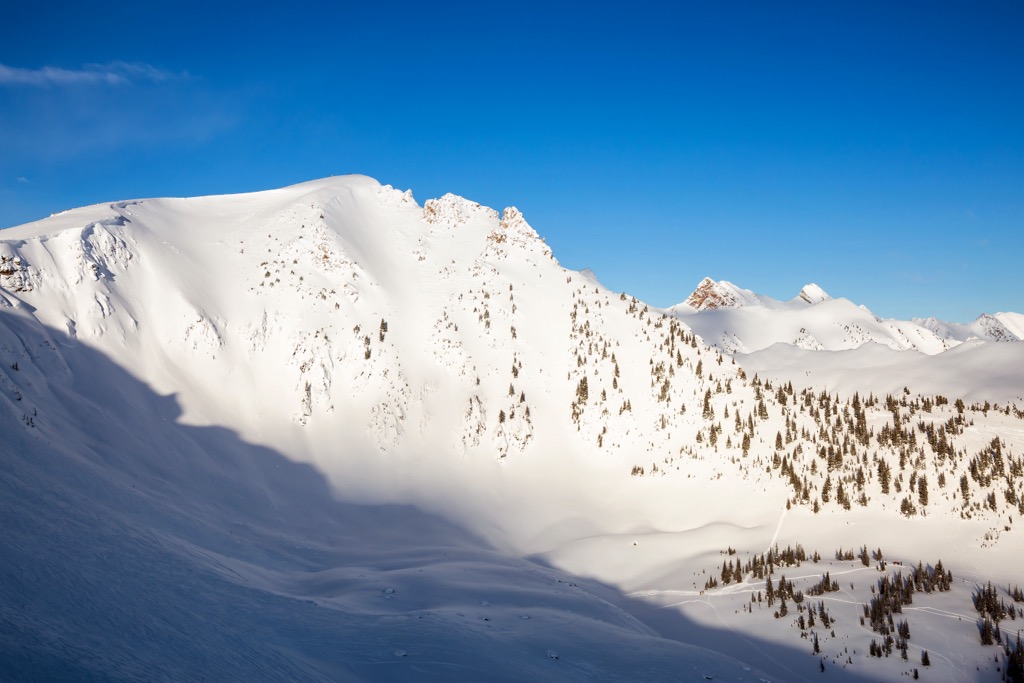
Sun Peaks is Canada’s second-largest ski resort. The resort boasts a peak elevation of 7,060 ft (2,152 m), a vertical drop of 2,891 ft (880 m), 13 ski lifts, and 137 ski runs spread over three unique mountain faces. In total, the resort has over 80 mi (130 km) of ski slopes and 4270 acres of skiable terrain. The resort’s chairlifts spin from late November to mid-April, weather permitting.
While they don’t receive as much snow as Revelstoke, the air can stay drier and colder, keeping conditions soft. Sun Peaks is more family-oriented than Revelstoke, and there is less of an off-piste scene here, although there is still great tree and bowl skiing.
